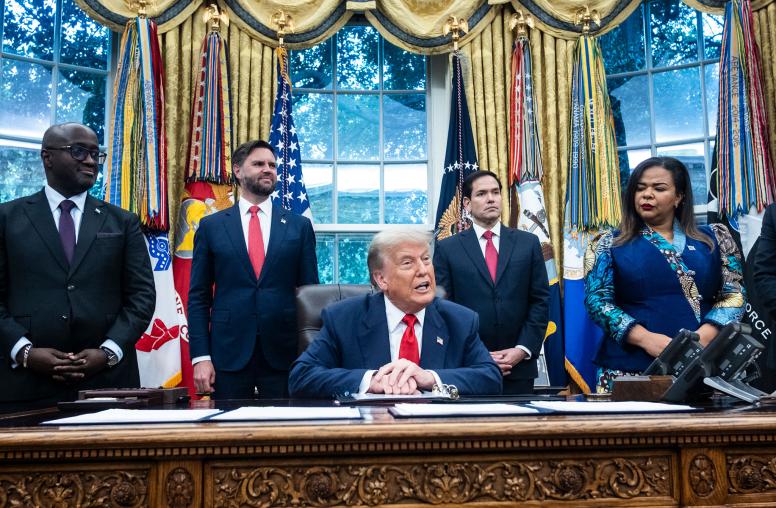1996-1997 National Winning Essay
Joseph Bernabucci
St. Albans School
District of Columbia
A Just and Lasting Peace: More than the Absence of War
The lives and prosperity of millions of people depend on peace and, in turn, peace depends on treaties - fragile documents that must do more than end wars. Negotiations and peace treaties may lead to decades of cooperation during which disputes between nations are resolved without military action and economic cost, or may prolong or even intensify the grievances which provoked conflict in the first place. In 1996, as Canada and the United States celebrated their mutual boundary as the longest undefended border in the world, Greece and Turkey nearly came to blows over a rocky island so small it scarcely had space for a flagpole.1 Both territorial questions had been raised as issues in peace treaties. The Treaty of Ghent in 1815 set the framework for the resolution of Canadian-American territorial questions. The Treaty of Sevres in 1920, between the Sultan and the victorious Allies of World War I, dismantled the remnants of the Ottoman Empire and distributed its territories. Examination of the terms and consequences of the two treaties clearly establishes that a successful treaty must provide more than the absence of war.
How do the terms or implementation of treaties determine peace or conflict decades later? Efforts to build a just and lasting peace are complicated not only because past grievances must be addressed, but future interests must be anticipated-even when such future interests were not identified as the cause of war in the first place. Edward Teller, discussing the Manhattan Project, observed, "No endeavor which is worthwhile is simple in prospect; if it is right, it will be simple in retrospect."2 Only if a nation perceives that continuing observance of the treaty will sustain the state over a long period of time and in changing circumstances, the peace and security promised by the treaty will endure. Machiavelli observed that ". . . fear of loss of the State by a prince or republic will overcome both gratitude and treaties."3
The Treaty of Ghent supports the notion that the essential long-term national interests of both parties are the most important factor in peace treaty success. Both the United States and Great Britain clearly perceived that they had real grievances and cause for war in 1812. However, within a short time, both nations realized they had a greater interest in peace without regard to most of the issues that provoked the conflict.
The United States, initially focusing on the infringement of its maritime rights and customs and commercial trade, specifically objected to impressment of its merchant seamen, and worried that the nation might be forced to fight a second war of independence if Britain did not recognize the rights of its citizens. The English sought, primarily, to "rectify"4 the border between Canada and the United States, establish a native American buffer around the Great Lakes, and secure Canada from invasion by land-hungry Americans.5
The Americans initiated mediation through a third party, Czar Alexander I of Russia, who organized delegations to both countries while hostilities were in progress. Direct negotiations began in 1814. By the time the Treaty was negotiated, Americans refocused on territorial security as their principal concern, while the British conceded any jurisdiction over American commerce and merchantmen to concentrate military resources in Europe. The initial demand of the Americans, the end of impressment, was also conceded without proclamation. The territorial settlement restored the status quo ante bellum despite the fact that the British had captured Washington and the Americans had achieved naval supremacy on the Great Lakes. Arrangements to pay for destroyed property were included with ambiguous terms for reparations.6 Both countries agreed to work toward abolishing the slave trade, and agreed to respect Indian rights. Most importantly, boundary commissions were established by the treaty, which made possible the peaceful and rapid resolution of future conflicts.7
In 1815, the Treaty of Ghent stood a good chance of success because neither side could gain more by continuing the military conflict in view of other pressing interests. Despite the fact that Great Britain maintained the strongest navy in the world and could have reduced America to its former status as a de facto colony, the English remained concerned about the threat by the French to shipping in the English Channel. By the time the treaty was ratified, only six weeks after it was signed, Napoleon was on the march again and the Americans had won the Battle of New Orleans. The strategic picture had changed for both countries in a matter of weeks. Both nations, however, recognized mutual benefits, and what became the essential goals of each nation dictated that the Treaty of Ghent be ratified and enforced.8
Perhaps most interesting, shortly after the War of 1812 was resolved, the British mercantile interests in the West Indies began to decline in relative terms and that nation's commercial interest in American cotton became more significant.9 Boundary issues and Indian rights became less important than a source of raw materials for industries in England.10 This was a change in the parties' interests that was not anticipated, but explained their willingness to settle on a stable national boundary.
In comparison to the Treaty of Ghent, the Treaty of Sevres can only be described as a short-term success and a long-term disaster. Signed in August 1920 by the representatives of Ottoman Turkey and the Allies of World War I, the treaty dismantled the Ottoman Empire for the benefit of various groups indigenous to the area and, not least of all, British, French, and Italian interests in the Middle East. France received a mandate in Syria, and Britain in Palestine and Iraq. Italy demanded Montenegro as a buffer between its territories and Serbia. Turkey gave up its rights to North Africa and the Arabian peninsula. Kurdestan and Armenia became autonomous. Greece dominated eastern Thrace, the Anatolian west coast, and most Aegean islands. The British, French, and Italian governments controlled the Turkish treasury.
The peace imposed on a captive Sultan did not demand indemnities, but the Turks believed the Treaty of Sevres was so unfair that Mustafa Kemal threatened to overthrow the Sultan. As Allies debated the use of military force to guarantee the Treaty, the United States refused to participate.11 The Sultan refused to ratify the Treaty, believing his government could not survive if he signed. In 1921, Kemal signed an agreement with Bolshevik Russia which crushed Armenian independence. The Treaty of Sevres rapidly crumbled.
The Treaty of Ghent, unlike the Treaty of Sevres, met the mutual national interest of warring parties, avoided onerous provisions, and was quickly implemented. In 1920, however, the diverse interests represented by the Allies and groups within the old Ottoman Empire12 made it impossible to identify essential interests and satisfy the most disaffected parties. France sought terms for a greater Syria and signed a separate treaty with Kemal, acting as foreign minister of Turkey. Great Britain supported the Sultan's government, but questioned the borders between its mandate, Iraq, and Turkey.
The Turks, unlike the Americans in 1815, viewed the treaty imposed on them as unfair. Although the Sultan attempted to finesse the Treaty he was dethroned. His successor, Kemal, also known as Atat¸rk, the father of modern Turkey, commenced hostilities against the Greeks to recover lost territories. Mediators provided little or no assistance or intervention. Perhaps the Allies didn't have the manpower, the money, or the will to supervise and enforce an imposed peace.13 The principal issues left unresolved by the Treaty of Sevres remain sources of regional disputes and potential world conflict to this day.
On the other hand, the British and the Americans initially used Russia as a third-party mediator and relied on a boundary commission to set the precedent for successful resolution of twelve subsequent disputes between the United States and what became sovereign Canada.14 The Treaty of Ghent has never been challenged.
In the future, peace treaties must provide for a great deal more than the absence of war. History has taught us that treaties must represent a "shared willingness"15 to identify the long-term, as well as the short-term, interests of all parties. Effective treaties must accurately identify such interests, not leave ambiguities or set onerous terms. To that end, in the twenty-first century nations must wage peace more creatively and aggressively than war in the twentieth century. Leaders committed to peace must receive support.16 A process for mediation, monitoring, and enforcement by a third party, or a mechanism for the resolution of disputes, will preserve the mutual interests of the parties in face of changing circumstances. Initial implementation should be rapid, before national interests, or the perceptions of those interests, changes. The Treaty of Ghent satisfied most of these criteria. The Treaty of Sevres did not.
Notes
1. Celestine Bohlen, "Dispute Still Simmering over Aegean Sea Islets," New York Times, 20 July 1996, A4. [Back]
2. Edward Teller, Better a Shield Than a Sword: Perspectives on Defense Technology (New York: Free Press, 1987), p. 241. [Back]
3. Lawrence W. Beilenson, The Treaty Trap: A History of the Performance of Political Treaties by the United States and European Nations (Washington, D.C.: Public Affairs Press, 1969), p. 11. [Back]
4. George Dangerfield, The Era of Good Feelings (New York: Harcourt, Brace & Co., 1952), p. 90. [Back]
5. John Mahon, The War of 1812 (Gainesville: University of Florida Press, 1972), pp. 383-384. [Back]
6. Ibid., p. 381. [Back]
7. Ibid., p. 381. [Back]
8. Dangerfield, p. 90. [Back]
9. J. C. A. Slagy, Mr. Madison's War (Princeton, N.J.: Princeton University Press, 1983), pp. 513-516. [Back]
10. Colin G. Calloway, "The End of an Era: British-Indian Relations in the Great Lakes Region After the War of 1812," Michigan Historical Review 12 (1986), p. 5. [Back]
11. Papers Relating to the Foreign Relations of the United States 1920 (Washington, D.C.: U.S. Government Printing Office, 1936), pp. 753 - 754. [Back]
12. J. A. S. Grenville, The Major International Treaties 1914-1973 (New York: Stein and Day, 1974), p. 51. [Back]
13. Ibid., p. 48. [Back]
14. Treaties in Force: A List of Treaties and Other International Agreements of the United States in Force on January 1, 1996 (Washington, D.C.: United States Department of State, Office of Legal Advisor, 1996), p. 36. [Back]
15. David P. Barash, Introduction to Peace Studies (Belmont, Calif.: Wadsworth Publishing Co., 1991), p. 100. [Back]
16. Jimmy Carter, Talking Peace: A Vision for the Next Generation (New York: Dutton Children's Books, 1993), p. 185. [Back]
Bibliography
Andonovksi, Hristo. "The Sevres Treaty for Macedonia and the Macedonians," Macedonian Review 11.3 (1981), pp. 271-278.
Barash, David P. Introduction to Peace Studies. Belmont, Calif.: Wadsworth Publishing Co., 1981.
Beilenson, Laurence W. The Treaty Trap: A History of the Performance of Political Treaties by the United States and European Nations. Washington, D.C.: Public Affairs Press, 1969.
Bohlen, Celestine. "Dispute Still Simmering over Aegean Sea Islets," New York Times, 20 July 1996, A4.
Calloway, Colin G. "The End of an Era: British-Indian Relations in the Great Lakes Region After the War of 1812," Michigan Historical Review 12 (1986), pp. 1-20.
Carter, Jimmy. Talking Peace: A Vision for the Next Generation. New York: Dutton Children's Books, 1993.
Dangerfield, George. The Era of Good Feelings. New York: Harcourt, Brace & Co., 1952.
Fahey, Joseph J., and Richard Armstrong. A Peace Reader. New York: Paulist Press, 1992.
Grenville, J. A. S. The Major International Treaties 1914-1973. New York: Stein and Day, 1974.
Fischer, Dietrich, William Nolte, Jan Oberg. Winning Peace. New York: Crane, Russak and Co., 1989.
Hampson, Fen Osler. Nurturing Peace: Why Peace Settlements Succeed or Fail. Washington, D.C: United States Institute of Peace Press, 1996.
Isard, Walter. Understanding Conflict and the Science of Peace. Cambridge, Mass.: Blackwell Publishers, 1992.
Kurat, Yulug Tekin. "Mustafa Kemal's Instructions to Beki Sami in London," Belleten 1.8 (1984), pp. 55-93.
Mahon, John. The War of 1812. Gainesville: University of Florida Press, 1972.
Macfie, A. L. "The Revision of the Treaty of Sevres: The First Phase," Balkan Studies, 24.1 (1983), pp. 57-88.
Marashlian, Levon. "The Armenian Question from Sevres to Lausanne." Middle Eastern Studies, 29.2 (1983), pp. 220-235.
Papers Relating to the Foreign Relations of the United States 1920. Washington, D.C.: U.S. Government Printing Office, 1936.
Parkes, Edward, ed. British and Foreign State Papers 1920 CXIII. London: His Majesty's Stationery Office, 1923.
Pear, Tom Hatherly. Psychological Factors of Peace and War. Freeport, N.Y.: Books for Libraries Press, 1971.
Rabow, Gerald. Peace Through Agreement: Replacing War with Non-Violent Dispute Resolution Methods. New York: Praeger Publishers, 1990.
Rahman, Habibur. "Kuwaite Ownership of Warba and Bubiyan Island." Middle Eastern Studies, 29.2 (1993), pp. 292-306.
Robins, Philip. "The Overlord State: Turkish Policy and the Kurdish Issue." International Affairs. 69.1 (1993), pp. 657-676.
Scheur, Michael F. "Who Should Own the Lakes? Negotiations Preceding the Treaty of Ghent." Inland Seas 38.4 (1982), pp. 236-244.
Slagy, J. C. A. Mr. Madison's War. Princeton, N.J.: Princeton University Press, 1983.
Taylor, A. J. P. How Wars End. London: Hamish Hamilton, Ltd., 1995.
Teller, Edward. Better a Shield Than a Sword: Perspectives on Defense Technology. New York: Free Press, 1987.
Treaties in Force: A List of Treaties and Other International Agreements of the United States in Force on January 1, 1996. Washington, D.C.: United States Department of State, Office of Legal Advisor, 1996.
Whitley, Andrew. "The Kurds: Pressures and Prospect: Lack of Leadership in Search for Nationhood." Round Table 279 (1980), pp. 245-257.
![]()




